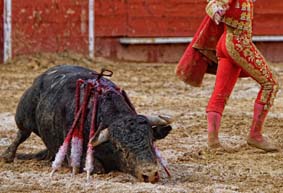
Universitat de València has issued a report refusing the declaration which considers bullfights and ‘bous al carrer’ as cultural heritage. The report had been requested by Valencian Ministry of Tourism, Culture and Sport. Universitat de València thinks that these practices with bulls ‘do not meet the requirements established by the Unesco Convention.’
The 21 pages report has been written by Antonio Ariño, the Vice-principal for Culture, Adela Cortina, full professor of philosophy of law; Gil Manuel Hernández, lecturer of sociology and social anthropology, Josep Montesinos, lecturer of art history, and Rafael Narbona Vizcaíno, full professor of medieval history.
Universitat de València, despite refusing bull festivities as cultural heritage, points out that these celebrations ‘over the time, have caused a bunch of objective expressions which make up the material dimension of these celebrations, and they should be preserved because of their artistic and documentary value.’
The report takes a historical tour of bull festivities from antiquity to the present time. It also cover the figure of the bull in the mythology, art and other social representations. The international conventions on cultural heritage, the respect to environment and poor treatment to animals are also analyzed.
According to the report, in the last years there has been a social change regarding the celebrations with bulls. The social support is decreasing and the different sectors’ rejection, especiall young people, is increasing.
According to a survey by Gallup in 2002, the percentage of people interested in bullfights was 31%. The survey carried out by the Ministry for Culture and the Fundación Autor show that the people attending the bullfights represent a much lower percentage, and this is progressively decreasing. The survey called Encuesta de Prácticas y Hábitos Culturales carried out in 2002-2003 shows that only 8.6% of the people has ever attended a bullfight and, men over women, and the elders prevail in this group. The bullfights attendance is higher in Navarra (25%) and Castilla-León and Castilla-La Mancha (19.2% and 17.7% respectively) over the rest of communities of Spain. The Valencian Community stands at 7.4%.
In the case of the festivity called ‘bous al carrer’, the report acknowledges that this festival has been extended and many festivities alike have arisen during the last three decades.
The report points out a change in the values of the Valencian society is happening. ‘One of the consequences of this change is the new concern for the environmental problems, civil rights, or the interest in social, political and aesthetic aspects of life. So, the social expressions based in poor treatment or violence to other live beings are progressively questioned.’
The report also states that ‘even though the cliché’s power is still presented to tourists as a ‘singular’ attraction, the questioning over these practices increases, and it extends to the abandonment of pets.’
These document recalls the more and more sensibility for the preservation of our environment and the peaceful humanitarism. These two trends together join ‘the ethical influence of the global organizations, as UNO and Unesco, to constitute an emerging global civil society rejecting violent cultural expressions or degrading people or animals.’
Then, there is the ‘bou embolat’ festiviy (which wrapps fire balls around the bull’s horns). The report talks about ‘an explicit mistreatment and violence towards the animal.’
Finally, the report states that many human activities provide economical profits, but they are not legally protected. People who practice them can even be prosecuted by law.
The report is available on: http://vrcultura.uv.es/cultura/altres/bousuv2012.pdf
Last update: 15 de june de 2012 13:22.
News release



















